
Third Quarter 2024 Earnings Conference Call Bill Rogers – Chairman & CEO Mike Maguire – CFO October 17, 2024

2 From time to time we have made, and in the future will make, forward-looking statements within the meaning of the Private Securities Litigation Reform Act of 1995. These statements can be identified by the fact that they do not relate strictly to historical or current facts. Forward-looking statements often use words such as “believe,” “expect,” “anticipate,” “intend,” “pursue,” “seek,” “continue,” “estimate,” “project,” “outlook,” “forecast,” “potential,” “target,” “objective,” “trend,” “plan,” “goal,” “initiative,” “priorities,” or other words of comparable meaning or future-tense or conditional verbs such as “may,” “will,” “should,” “would,” or “could.” Forward-looking statements convey our expectations, intentions, or forecasts about future events, circumstances, or results. In particular, forward looking statements include, but are not limited to, statements we make about: (i) Truist’s capacity to generate business growth and increase capital returns in future periods, (ii) opportunities to improve Truist’s profitability, (iii) guidance with respect to financial performance metrics in future periods, including future levels of adjusted revenue, adjusted expenses, and net charge-off ratio; (iv) Truist’s effective tax rate in future periods; (v) scheduled office loan maturities in future years; and (vi) projections of preferred dividends. This presentation, including any information incorporated by reference in this presentation, contains forward-looking statements. We also may make forward-looking statements in other documents that are filed or furnished with the SEC. In addition, we may make forward-looking statements orally or in writing to investors, analysts, members of the media, and others. All forward- looking statements, by their nature, are subject to assumptions, risks, and uncertainties, which may change over time and many of which are beyond our control. You should not rely on any forward-looking statement as a prediction or guarantee about the future. Actual future objectives, strategies, plans, prospects, performance, conditions, and results may differ materially from those set forth in any forward-looking statement. While no list of assumptions, risks, and uncertainties could be complete, some of the factors that may cause actual results or other future events or circumstances to differ from those in forward-looking statements include: • evolving political, business, economic, and market conditions at local, regional, national, and international levels; • monetary, fiscal, and trade laws or policies, including as a result of actions by governmental agencies, central banks, or supranational authorities; • the legal, regulatory, and supervisory environment, including changes in financial-services legislation, regulation, policies, or government officials or other personnel; • our ability to address heightened scrutiny and expectations from supervisory or other governmental authorities and to timely and credibly remediate related concerns or deficiencies; • judicial, regulatory, and administrative inquiries, examinations, investigations, proceedings, disputes, or rulings that create uncertainty for or are adverse to us or the financial-services industry; • the outcomes of judicial, regulatory, and administrative inquiries, examinations, investigations, proceedings, or disputes to which we are or may be subject (either directly or indirectly through our ownership interests in joint ventures or other legal entities) and our ability to absorb and address any damages or other remedies that are sought or awarded and any collateral consequences; • evolving accounting standards and policies; • the adequacy of our corporate governance, risk-management framework, compliance programs, and internal controls over financial reporting, including our ability to control lapses or deficiencies in financial reporting, to make appropriate estimates, or to effectively mitigate or manage operational risk; • any instability or breakdown in the financial system, including as a result of the actual or perceived soundness of another financial institution or another participant in the financial system; • disruptions and shifts in investor sentiment or behavior in the securities, capital, or other financial markets, including financial or systemic shocks and volatility or changes in market liquidity, interest or currency rates, or valuations; • our ability to cost-effectively fund our businesses and operations, including by accessing long- and short-term funding and liquidity and by retaining and growing client deposits; • changes in any of our credit ratings; • our ability to manage any unexpected outflows of uninsured deposits and avoid selling investment securities or other assets at an unfavorable time or at a loss; • negative market perceptions of our investment portfolio or its value; • adverse publicity or other reputational harm to us, our service providers, or our senior officers; • business and consumer sentiment, preferences, or behavior, including spending, borrowing, or saving by businesses or households; • our ability to execute on strategic and operational plans, including accelerating growth, improving profitability, and returning capital to shareholders; • changes in our corporate and business strategies, the composition of our assets, or the way in which we fund those assets; • our ability to successfully make and integrate acquisitions and to effect divestitures, including the ability to perform our obligations under the transition services arrangements supporting TIH in a cost-effective and efficient manner; • our ability to develop, maintain, and market our products or services or to absorb unanticipated costs or liabilities associated with those products or services; • our ability to innovate, to anticipate the needs of current or future clients, to successfully compete, to increase or hold market share in changing competitive environments, or to deal with pricing or other competitive pressures; • our ability to maintain secure and functional financial, accounting, technology, data processing, or other operating systems or infrastructure, including those that safeguard personal and other sensitive information; • our ability to appropriately underwrite loans that we originate or purchase and to otherwise manage credit risk; • our ability to satisfactorily and profitably perform loan servicing and similar obligations; • the credit, liquidity, or other financial condition of our clients, counterparties, service providers, or competitors; • our ability to effectively deal with economic, business, or market slowdowns or disruptions; • the efficacy of our methods or models in assessing business strategies or opportunities or in valuing, measuring, estimating, monitoring, or managing positions or risk; • our ability to keep pace with changes in technology that affect us or our clients, counterparties, service providers, or competitors or to maintain rights or interests in associated intellectual property; • our ability to attract, hire, and retain key teammates and to engage in adequate succession planning; • the performance and availability of third-party service providers on whom we rely in delivering products and services to our clients and otherwise in conducting our business and operations; • our ability to detect, prevent, mitigate, and otherwise manage the risk of fraud or misconduct by internal or external parties; our ability to manage and mitigate physical-security and cybersecurity risks, including denial-of-service attacks, hacking, phishing, social-engineering attacks, malware intrusion, data-corruption attempts, system breaches, identity theft, ransomware attacks, environmental conditions, and intentional acts of destruction; • natural or other disasters, calamities, and conflicts, including terrorist events, cyber-warfare, and pandemics; • widespread outages of operational, communication, and other systems; • our ability to maintain appropriate corporate responsibility practices, oversight, and disclosures; • policies and other actions of governments to manage and mitigate climate and related environmental risks, and the effects of climate change or the transition to a lower-carbon economy on our business, operations, and reputation; and • other assumptions, risks, or uncertainties described in the Risk Factors (Item 1A), Management’s Discussion and Analysis of Financial Condition and Results of Operations (Item 7), or the Notes to the Consolidated Financial Statements (Item 8) in our Annual Report on Form 10-K or described in any of the Company’s subsequent quarterly or current reports. Any forward-looking statement made by us or on our behalf speaks only as of the date that it was made. We do not undertake to update any forward-looking statement to reflect the impact of events, circumstances, or results that arise after the date that the statement was made, except as required by applicable securities laws. You, however, should consult further disclosures (including disclosures of a forward-looking nature) that we may make in any subsequent Annual Report on Form 10-K, Quarterly Report on Form 10-Q, or Current Report on Form 8-K. Forward-Looking Statements

3 Non-GAAP Information This presentation contains financial information and performance measures determined by methods other than in accordance with accounting principles generally accepted in the United States of America ("GAAP"). Truist’s management uses these “non-GAAP” measures in their analysis of the Corporation's performance and the efficiency of its operations. Management believes these non-GAAP measures are useful to investors because they provide a greater understanding of ongoing operations, enhance comparability of results with prior periods and demonstrate the effects of significant items in the current period. The Company believes a meaningful analysis of its financial performance requires an understanding of the factors underlying that performance. These disclosures should not be viewed as a substitute for financial measures determined in accordance with GAAP, nor are they necessarily comparable to non-GAAP performance measures that may be presented by other companies. Below is a listing of the types of non-GAAP measures used in this presentation: Adjusted Net income Available to Common Shareholders and Adjusted Diluted Earnings Per Share - Adjusted net income available to common shareholders and adjusted diluted earnings per share are non-GAAP in that these measures exclude selected items, net of tax. Truist’s management uses these measures in their analysis of the Corporation’s performance. Truist’s management believes these measures provide a greater understanding of ongoing operations and enhance comparability of results with prior periods, as well as demonstrate the effects of significant gains and charges. Adjusted Efficiency Ratio, Adjusted Fee Income, and Related Measures - The adjusted efficiency ratio is non-GAAP in that it excludes securities gains and losses, amortization of intangible assets, restructuring charges, and other selected items. Adjusted revenue and adjusted noninterest expense are related measures used to calculate the adjusted efficiency ratio. Additionally, the adjusted fee income ratio is non-GAAP in that it excludes securities gains and losses and other selected items, and is calculated using adjusted revenue and adjusted noninterest income. Adjusted revenue and adjusted noninterest income exclude securities gains and losses and other selected items. Adjusted noninterest expense excludes amortization of intangible assets, restructuring charges, and other selected items. Truist’s management calculated these measures based on the Company’s continuing operations. Truist’s management uses these measures in their analysis of the Corporation’s performance. Truist’s management believes these measures provide a greater understanding of ongoing operations and enhance comparability of results with prior periods, as well as demonstrate the effects of significant gains and charges. Pre-Provision Net Revenue (PPNR) - Pre-provision net revenue is a non-GAAP measure that adjusts net income determined in accordance with GAAP to exclude the impact of the provision for credit losses and provision for income taxes. Adjusted pre-provision net revenue is a non- GAAP measure that additionally excludes securities gains (losses), restructuring charges, amortization of intangible assets, and other selected items. Truist’s management calculated these measures based on the Company’s continuing operations. Truist’s management believes these measures provide a greater understanding of ongoing operations and enhance comparability of results with prior periods. Tangible Common Equity and Related Measures - Tangible common equity and related measures are non-GAAP measures that exclude the impact of intangible assets, net of deferred taxes, and their related amortization and impairment charges. These measures are useful for evaluating the performance of a business consistently, whether acquired or developed internally. Truist’s management uses these measures to assess profitability, returns relative to balance sheet risk, and shareholder value.
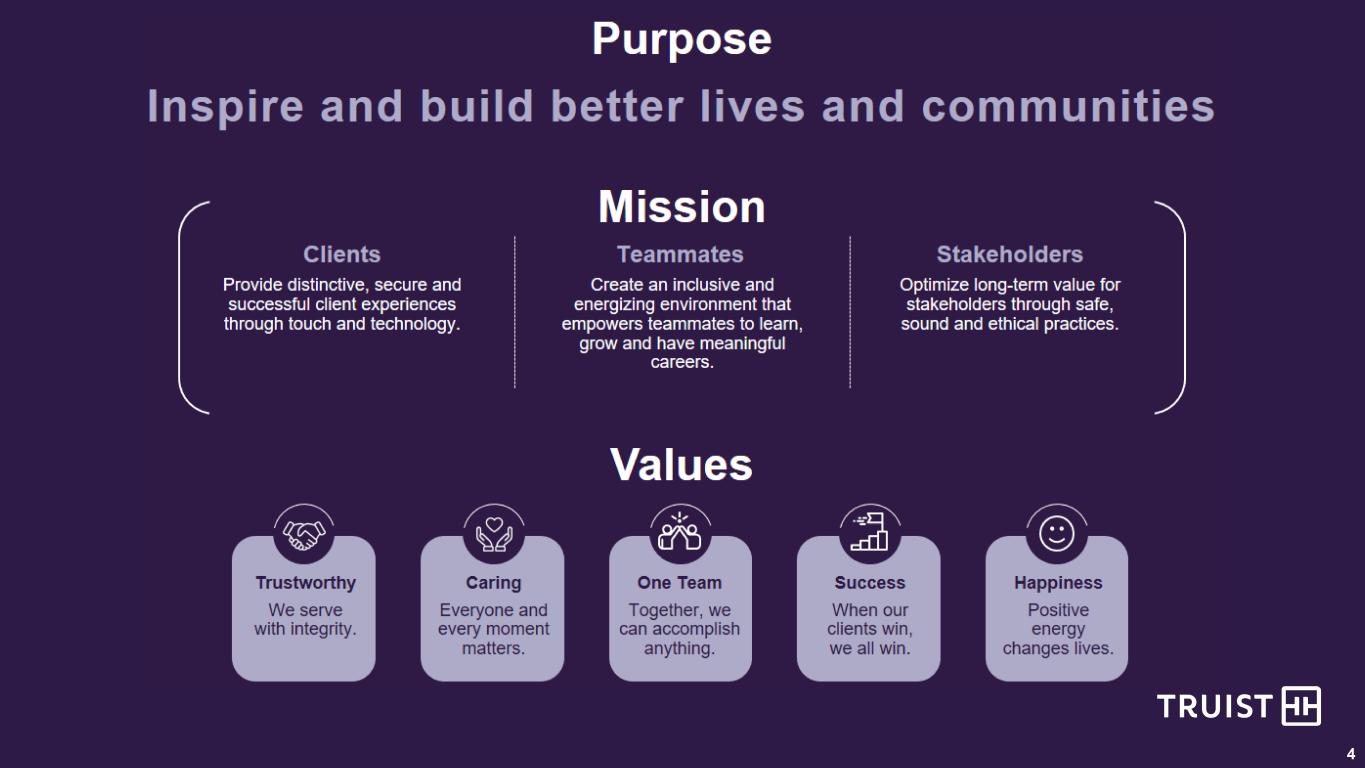
4
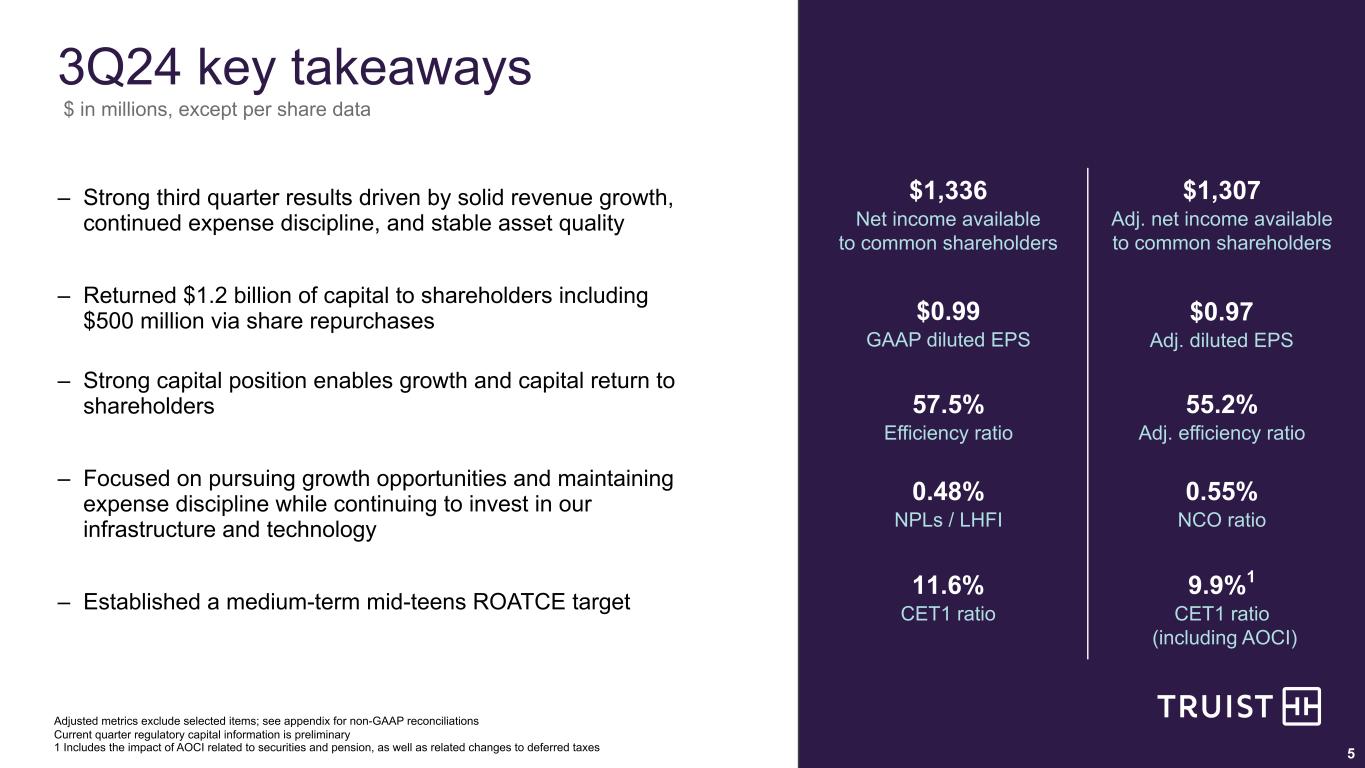
5 – Strong third quarter results driven by solid revenue growth, continued expense discipline, and stable asset quality – Returned $1.2 billion of capital to shareholders including $500 million via share repurchases – Strong capital position enables growth and capital return to shareholders – Focused on pursuing growth opportunities and maintaining expense discipline while continuing to invest in our infrastructure and technology – Established a medium-term mid-teens ROATCE target 3Q24 key takeaways $0.99 GAAP diluted EPS $0.97 Adj. diluted EPS 57.5% Efficiency ratio 55.2% Adj. efficiency ratio 0.48% NPLs / LHFI 11.6% CET1 ratio Adjusted metrics exclude selected items; see appendix for non-GAAP reconciliations Current quarter regulatory capital information is preliminary 1 Includes the impact of AOCI related to securities and pension, as well as related changes to deferred taxes 9.9%1 CET1 ratio (including AOCI) 0.55% NCO ratio $1,336 Net income available to common shareholders $1,307 Adj. net income available to common shareholders $ in millions, except per share data
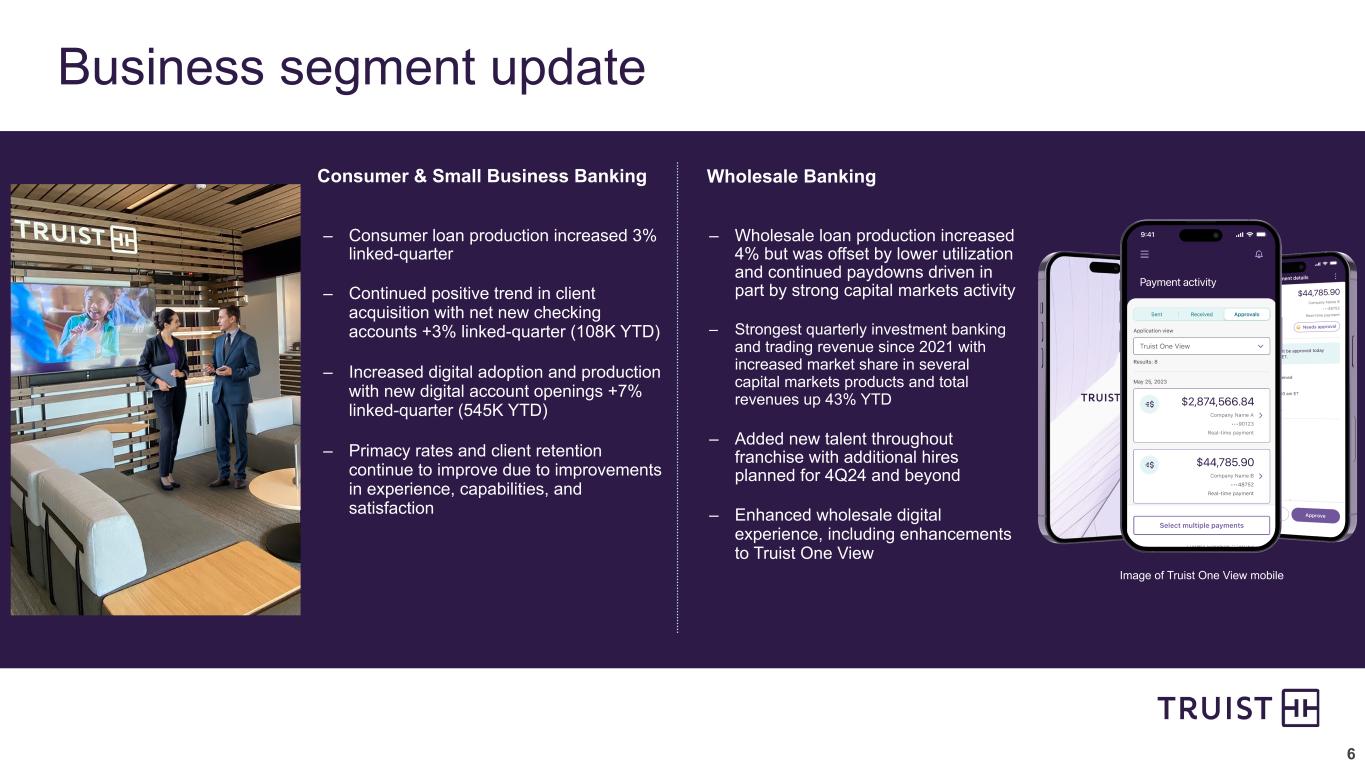
6 Consumer & Small Business Banking – Consumer loan production increased 3% linked-quarter – Continued positive trend in client acquisition with net new checking accounts +3% linked-quarter (108K YTD) – Increased digital adoption and production with new digital account openings +7% linked-quarter (545K YTD) – Primacy rates and client retention continue to improve due to improvements in experience, capabilities, and satisfaction Wholesale Banking – Wholesale loan production increased 4% but was offset by lower utilization and continued paydowns driven in part by strong capital markets activity – Strongest quarterly investment banking and trading revenue since 2021 with increased market share in several capital markets products and total revenues up 43% YTD – Added new talent throughout franchise with additional hires planned for 4Q24 and beyond – Enhanced wholesale digital experience, including enhancements to Truist One View Business segment update Image of Truist One View mobile
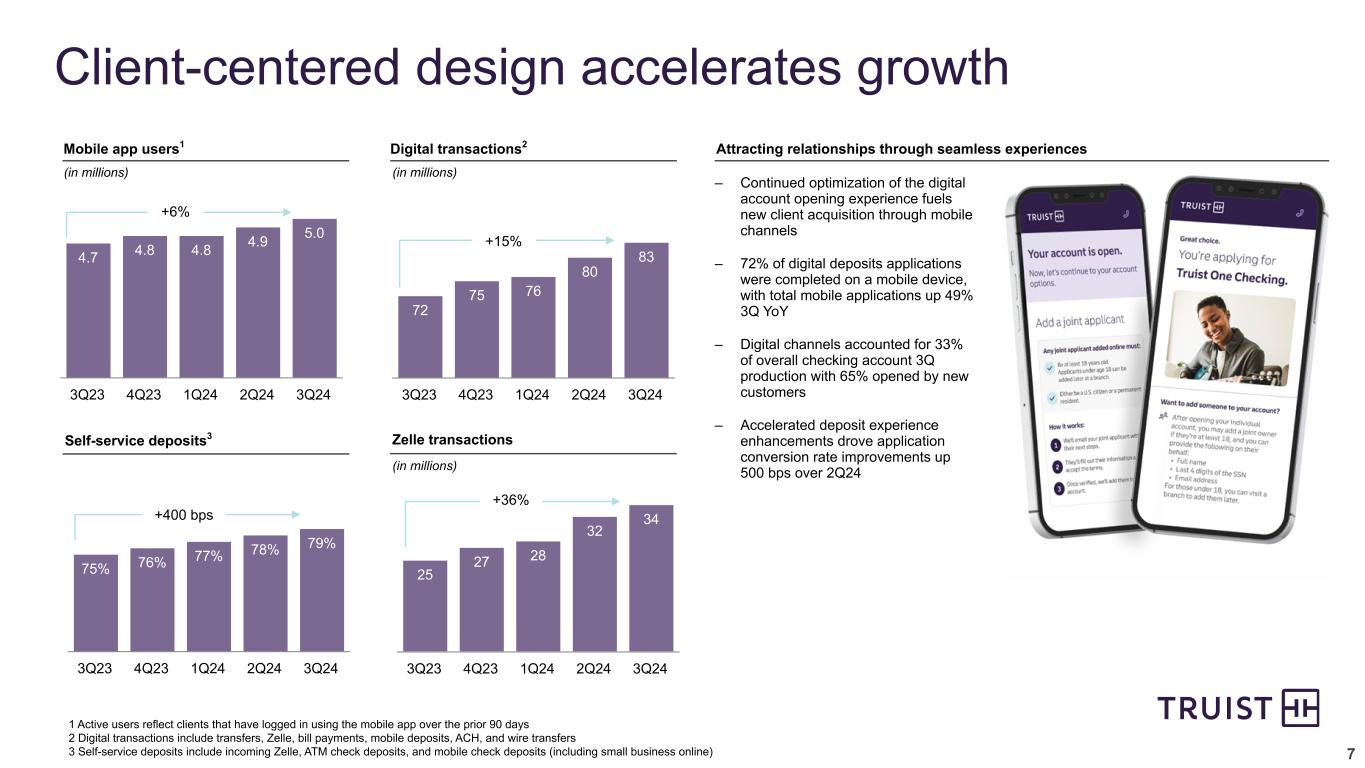
7 Attracting relationships through seamless experiences 25 27 28 32 34 3Q23 4Q23 1Q24 2Q24 3Q24 4.7 4.8 4.8 4.9 5.0 3Q23 4Q23 1Q24 2Q24 3Q24 1 Active users reflect clients that have logged in using the mobile app over the prior 90 days 2 Digital transactions include transfers, Zelle, bill payments, mobile deposits, ACH, and wire transfers 3 Self-service deposits include incoming Zelle, ATM check deposits, and mobile check deposits (including small business online) Mobile app users1 Digital transactions2 Self-service deposits3 Zelle transactions 75% 76% 77% 78% 79% 3Q23 4Q23 1Q24 2Q24 3Q24 +6% +400 bps +36% (in millions) (in millions) – Continued optimization of the digital account opening experience fuels new client acquisition through mobile channels – 72% of digital deposits applications were completed on a mobile device, with total mobile applications up 49% 3Q YoY – Digital channels accounted for 33% of overall checking account 3Q production with 65% opened by new customers – Accelerated deposit experience enhancements drove application conversion rate improvements up 500 bps over 2Q24 72 75 76 80 83 3Q23 4Q23 1Q24 2Q24 3Q24 +15% (in millions) Client-centered design accelerates growth
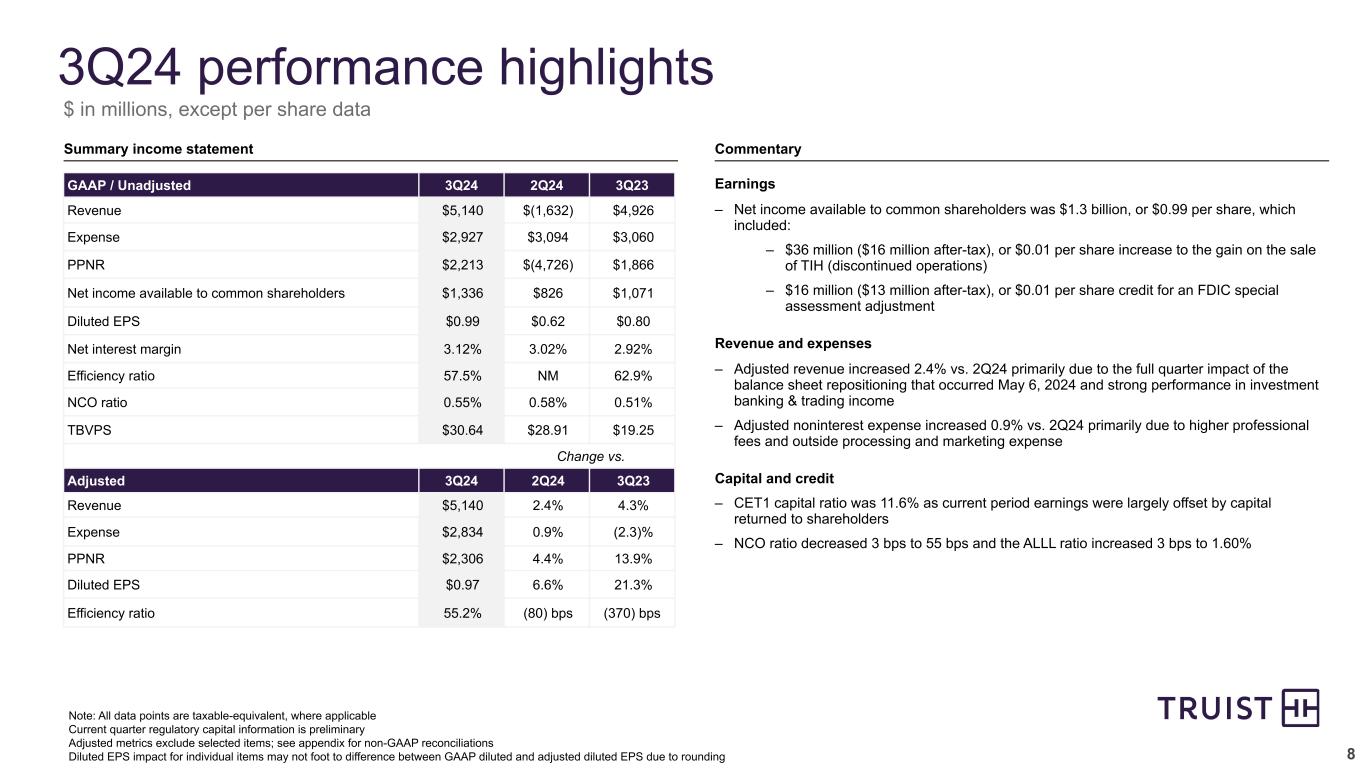
8 Earnings – Net income available to common shareholders was $1.3 billion, or $0.99 per share, which included: – $36 million ($16 million after-tax), or $0.01 per share increase to the gain on the sale of TIH (discontinued operations) – $16 million ($13 million after-tax), or $0.01 per share credit for an FDIC special assessment adjustment Revenue and expenses – Adjusted revenue increased 2.4% vs. 2Q24 primarily due to the full quarter impact of the balance sheet repositioning that occurred May 6, 2024 and strong performance in investment banking & trading income – Adjusted noninterest expense increased 0.9% vs. 2Q24 primarily due to higher professional fees and outside processing and marketing expense Capital and credit – CET1 capital ratio was 11.6% as current period earnings were largely offset by capital returned to shareholders – NCO ratio decreased 3 bps to 55 bps and the ALLL ratio increased 3 bps to 1.60% Note: All data points are taxable-equivalent, where applicable Current quarter regulatory capital information is preliminary Adjusted metrics exclude selected items; see appendix for non-GAAP reconciliations Diluted EPS impact for individual items may not foot to difference between GAAP diluted and adjusted diluted EPS due to rounding Summary income statement $ in millions, except per share data GAAP / Unadjusted 3Q24 2Q24 3Q23 Revenue $5,140 $(1,632) $4,926 Expense $2,927 $3,094 $3,060 PPNR $2,213 $(4,726) $1,866 Net income available to common shareholders $1,336 $826 $1,071 Diluted EPS $0.99 $0.62 $0.80 Net interest margin 3.12% 3.02% 2.92% Efficiency ratio 57.5% NM 62.9% NCO ratio 0.55% 0.58% 0.51% TBVPS $30.64 $28.91 $19.25 Change vs. Adjusted 3Q24 2Q24 3Q23 Revenue $5,140 2.4% 4.3% Expense $2,834 0.9% (2.3)% PPNR $2,306 4.4% 13.9% Diluted EPS $0.97 6.6% 21.3% Efficiency ratio 55.2% (80) bps (370) bps Commentary 3Q24 performance highlights
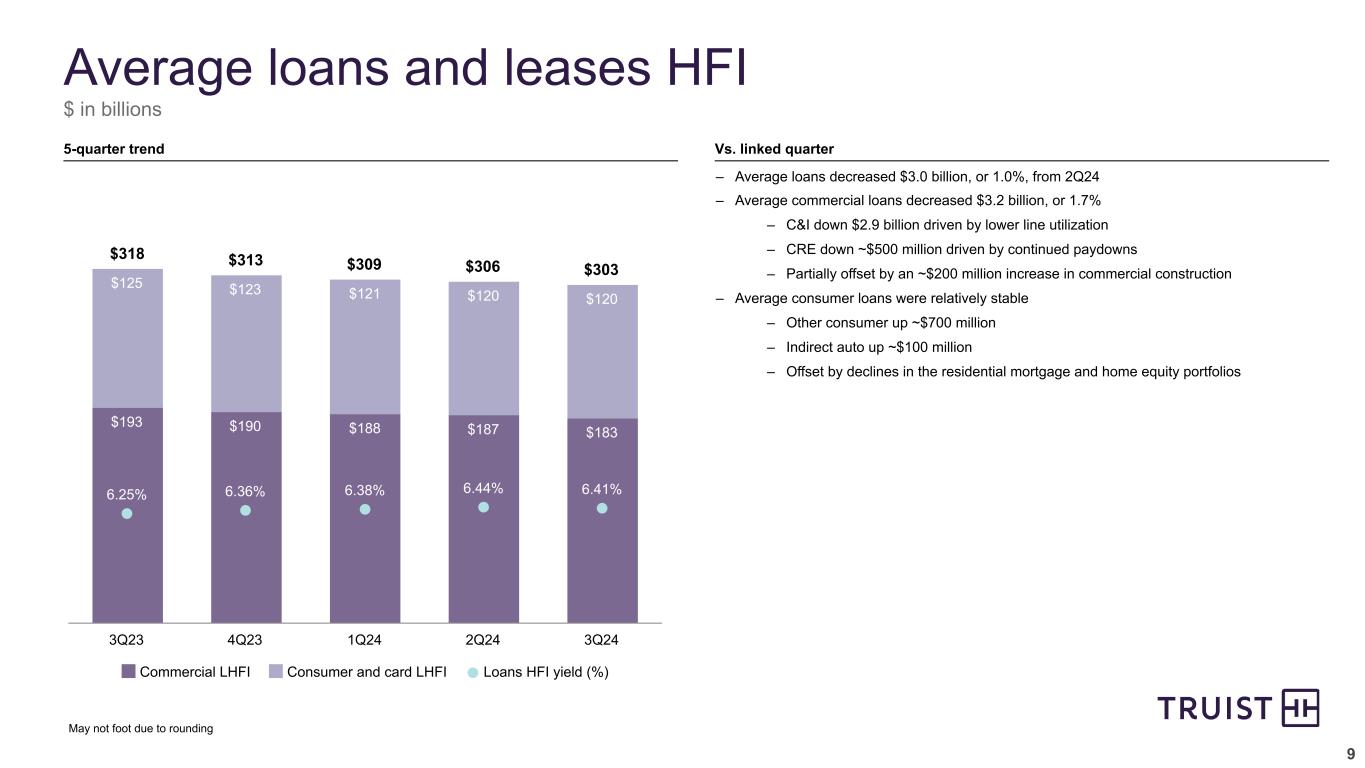
9 $318 $313 $309 $306 $303 $193 $190 $188 $187 $183 $125 $123 $121 $120 $120 6.25% 6.36% 6.38% 6.44% 6.41% Commercial LHFI Consumer and card LHFI Loans HFI yield (%) 3Q23 4Q23 1Q24 2Q24 3Q24 Average loans and leases HFI $ in billions – Average loans decreased $3.0 billion, or 1.0%, from 2Q24 – Average commercial loans decreased $3.2 billion, or 1.7% – C&I down $2.9 billion driven by lower line utilization – CRE down ~$500 million driven by continued paydowns – Partially offset by an ~$200 million increase in commercial construction – Average consumer loans were relatively stable – Other consumer up ~$700 million – Indirect auto up ~$100 million – Offset by declines in the residential mortgage and home equity portfolios 5-quarter trend Vs. linked quarter May not foot due to rounding

10 Average deposits $ in billions $401 $395 $389 $388 $384 $282 $281 $280 $280 $278 $119 $115 $109 $108 $106 1.84% 1.92% 2.03% 2.09% 2.08% Interest-bearing deposits Noninterest-bearing deposits Total deposit cost (%) 3Q23 4Q23 1Q24 2Q24 3Q24 May not foot due to rounding Client deposits exclude brokered deposits and negotiable CDs – Average deposits decreased $3.7 billion, or 1.0% – Average client deposits declined $2.0 billion driven by a: – $1.6 billion decline in average noninterest-bearing deposits, and – $1.4 billion decline in retail time deposits, partially offset by – $700 million increase in client interest checking – $300 million increase in client money market and savings deposits – Average noninterest-bearing deposits represented 28% of total deposits, which is consistent with 2Q24 – Average wholesale and brokered deposits declined $1.7 billion, which resulted in lower deposit costs – Total cost of deposits was 208 bps, down 1 bp from the prior quarter – Total cost of interest-bearing deposits was 288 bps, down 1 bp from the prior quarter Vs. linked quarter 5-quarter trend
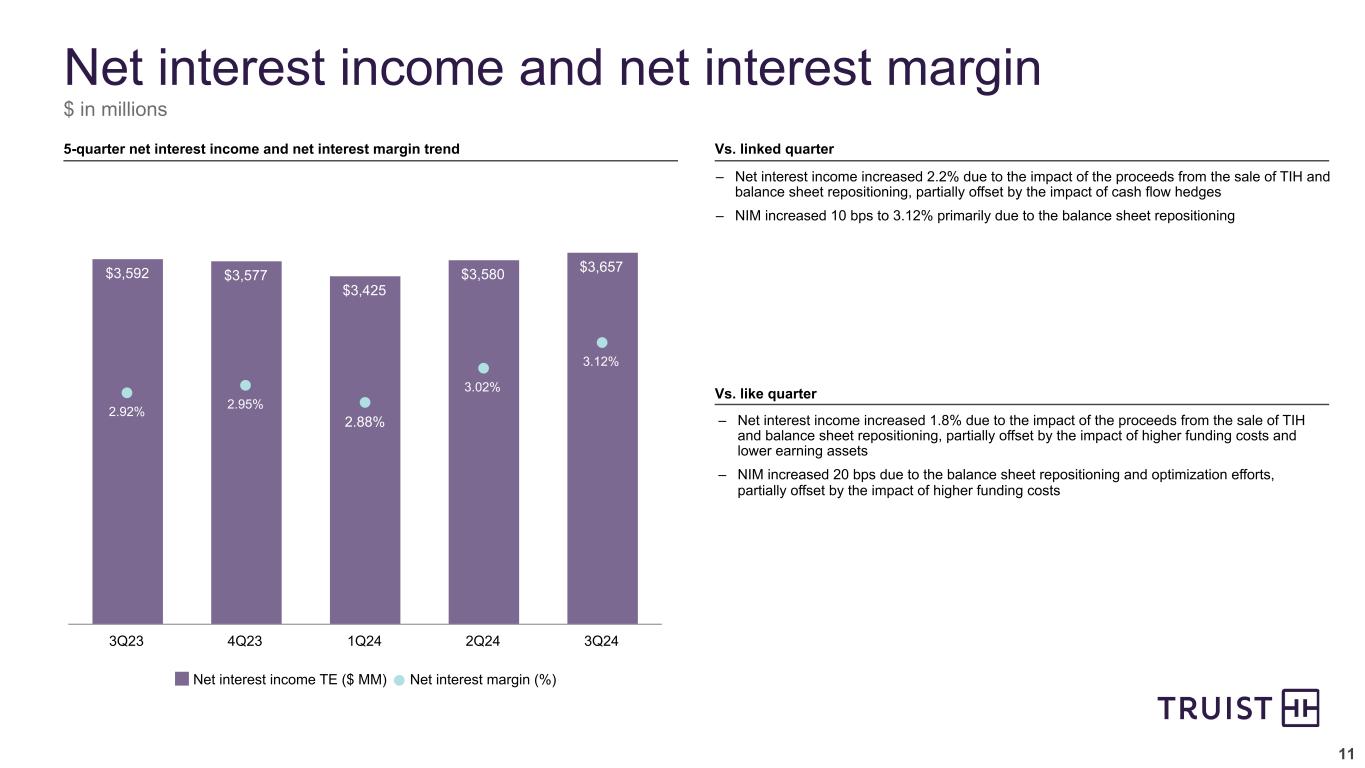
11 $3,592 $3,577 $3,425 $3,580 $3,657 2.92% 2.95% 2.88% 3.02% 3.12% Net interest income TE ($ MM) Net interest margin (%) 3Q23 4Q23 1Q24 2Q24 3Q24 – Net interest income increased 1.8% due to the impact of the proceeds from the sale of TIH and balance sheet repositioning, partially offset by the impact of higher funding costs and lower earning assets – NIM increased 20 bps due to the balance sheet repositioning and optimization efforts, partially offset by the impact of higher funding costs Net interest income and net interest margin 5-quarter net interest income and net interest margin trend $ in millions $5 $2 Vs. linked quarter Vs. like quarter – Net interest income increased 2.2% due to the impact of the proceeds from the sale of TIH and balance sheet repositioning, partially offset by the impact of cash flow hedges – NIM increased 10 bps to 3.12% primarily due to the balance sheet repositioning
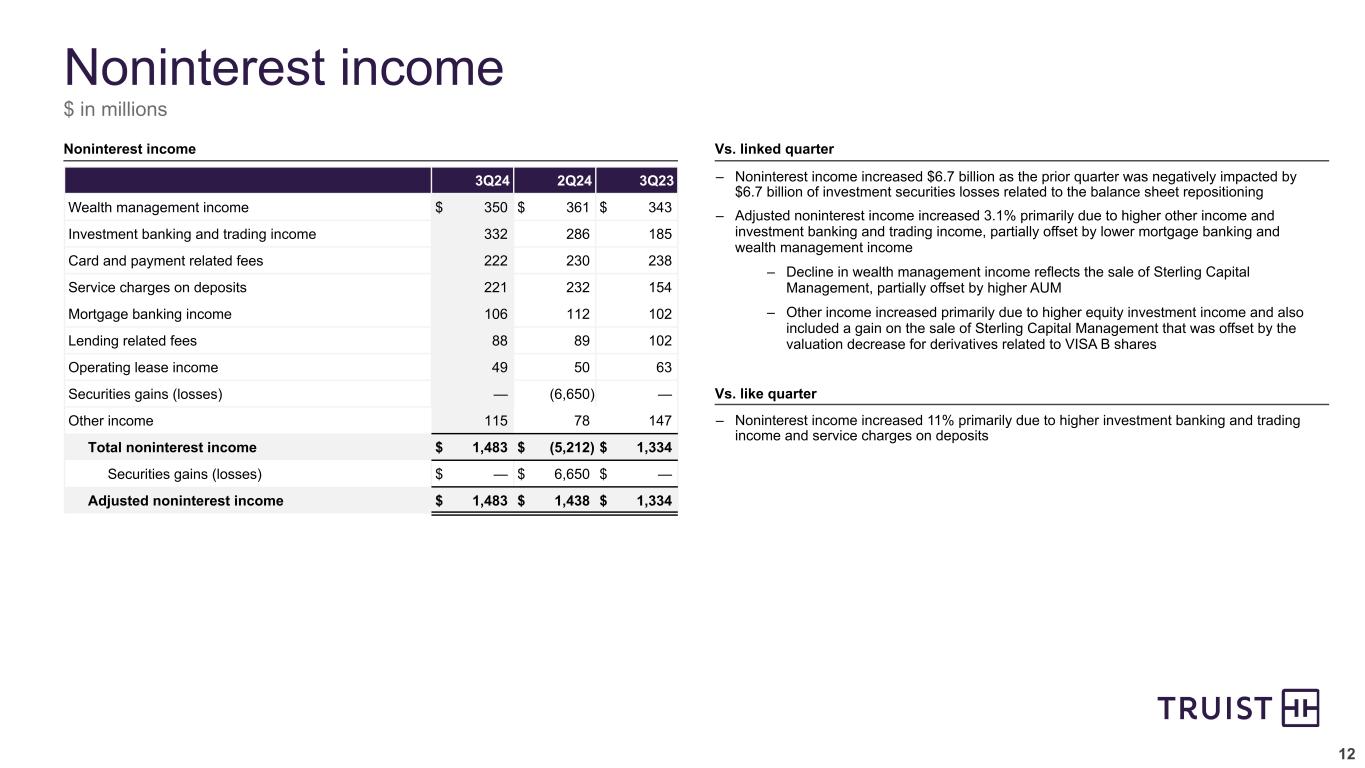
12 – Noninterest income increased 11% primarily due to higher investment banking and trading income and service charges on deposits – Noninterest income increased $6.7 billion as the prior quarter was negatively impacted by $6.7 billion of investment securities losses related to the balance sheet repositioning – Adjusted noninterest income increased 3.1% primarily due to higher other income and investment banking and trading income, partially offset by lower mortgage banking and wealth management income – Decline in wealth management income reflects the sale of Sterling Capital Management, partially offset by higher AUM – Other income increased primarily due to higher equity investment income and also included a gain on the sale of Sterling Capital Management that was offset by the valuation decrease for derivatives related to VISA B shares Noninterest income Vs. linked quarter Vs. like quarter Noninterest income 3Q24 2Q24 3Q23 Wealth management income $ 350 $ 361 $ 343 Investment banking and trading income 332 286 185 Card and payment related fees 222 230 238 Service charges on deposits 221 232 154 Mortgage banking income 106 112 102 Lending related fees 88 89 102 Operating lease income 49 50 63 Securities gains (losses) — (6,650) — Other income 115 78 147 Total noninterest income $ 1,483 $ (5,212) $ 1,334 Securities gains (losses) $ — $ 6,650 $ — Adjusted noninterest income $ 1,483 $ 1,438 $ 1,334 $ in millions
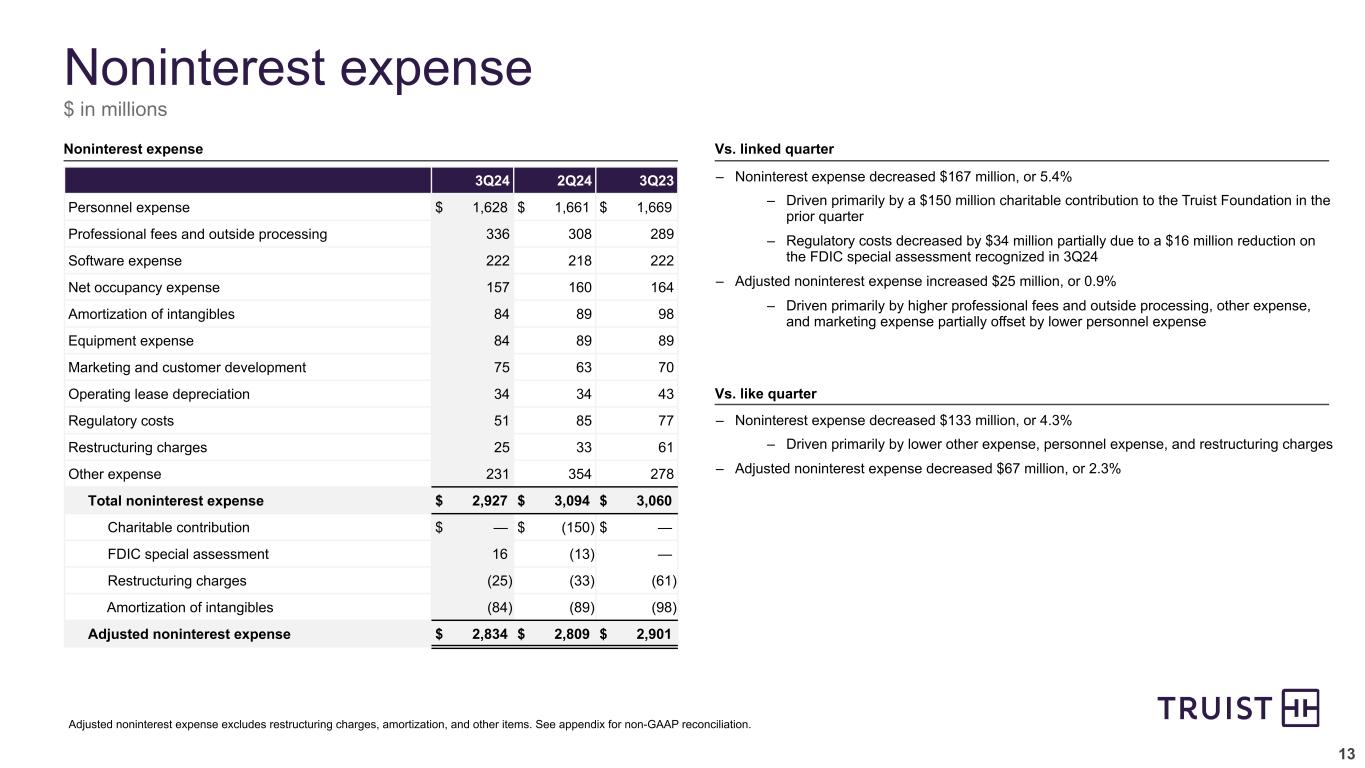
13 – Noninterest expense decreased $167 million, or 5.4% – Driven primarily by a $150 million charitable contribution to the Truist Foundation in the prior quarter – Regulatory costs decreased by $34 million partially due to a $16 million reduction on the FDIC special assessment recognized in 3Q24 – Adjusted noninterest expense increased $25 million, or 0.9% – Driven primarily by higher professional fees and outside processing, other expense, and marketing expense partially offset by lower personnel expense – Noninterest expense decreased $133 million, or 4.3% – Driven primarily by lower other expense, personnel expense, and restructuring charges – Adjusted noninterest expense decreased $67 million, or 2.3% Noninterest expense Vs. linked quarter Vs. like quarter $54 Adjusted noninterest expense excludes restructuring charges, amortization, and other items. See appendix for non-GAAP reconciliation. 3Q24 2Q24 3Q23 Personnel expense $ 1,628 $ 1,661 $ 1,669 Professional fees and outside processing 336 308 289 Software expense 222 218 222 Net occupancy expense 157 160 164 Amortization of intangibles 84 89 98 Equipment expense 84 89 89 Marketing and customer development 75 63 70 Operating lease depreciation 34 34 43 Regulatory costs 51 85 77 Restructuring charges 25 33 61 Other expense 231 354 278 Total noninterest expense $ 2,927 $ 3,094 $ 3,060 Charitable contribution $ — $ (150) $ — FDIC special assessment 16 (13) — Restructuring charges (25) (33) (61) Amortization of intangibles (84) (89) (98) Adjusted noninterest expense $ 2,834 $ 2,809 $ 2,901 Noninterest expense $ in millions
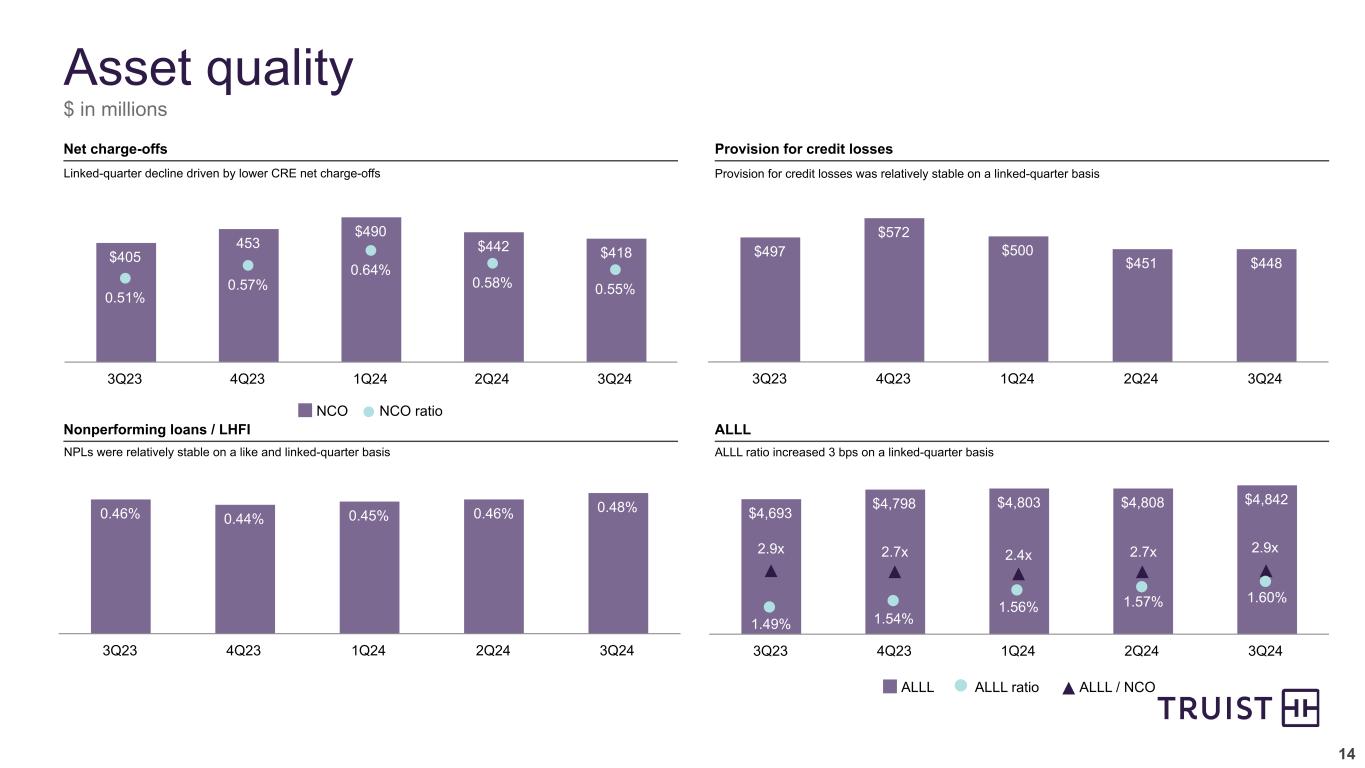
14 $497 $572 $500 $451 $448 3Q23 4Q23 1Q24 2Q24 3Q24 NPLs were relatively stable on a like and linked-quarter basis Provision for credit losses was relatively stable on a linked-quarter basis $405 453 $490 $442 $418 0.51% 0.57% 0.64% 0.58% 0.55% NCO NCO ratio 3Q23 4Q23 1Q24 2Q24 3Q24 Linked-quarter decline driven by lower CRE net charge-offs Asset quality 4.5x 9.0x 8.8x Net charge-offs Provision for credit losses Nonperforming loans / LHFI ALLL $4,693 $4,798 $4,803 $4,808 $4,842 ALLL ALLL ratio ALLL / NCO 3Q23 4Q23 1Q24 2Q24 3Q24 ALLL ratio increased 3 bps on a linked-quarter basis 0.46% 0.44% 0.45% 0.46% 0.48% 3Q23 4Q23 1Q24 2Q24 3Q24 2.9x 1.49% 2.7x 1.54% 2.4x 1.56% 2.7x 1.57% 1.60% 2.9x $ in millions

15 – CET1 capital ratio remained stable at 11.6% as current period earnings were offset by capital returned to shareholders – Returned $1.2 billion of capital to shareholders through our common stock dividend and $500 million of share repurchases – Increased CET1 capital ratio including AOCI 30 bps to 9.9%1 – Grew tangible book value per share 6.0% as a $1.6 billion improvement in AOCI offset the impact of capital return to shareholders – As of 9/30, we have $4.5 billion remaining under our initial $5 billion repurchase authorization with $500 million of buybacks expected to occur in 4Q24 2Q24 CET1 ratio Current period earnings and RWA change Dividend payment Share repurchase 3Q24 CET1 ratio 9.9% 11.6% +0.30% 11.6% 3Q24 capital walk (0.20%) 9.9% including AOCI1 (0.10%) 9.6% including AOCI Commentary Capital Future earnings and AOCI accretion create significant capacity for growth and capital return Current quarter regulatory capital information is preliminary 1 Includes the impact of AOCI related to securities and pension, as well as related changes to deferred taxes
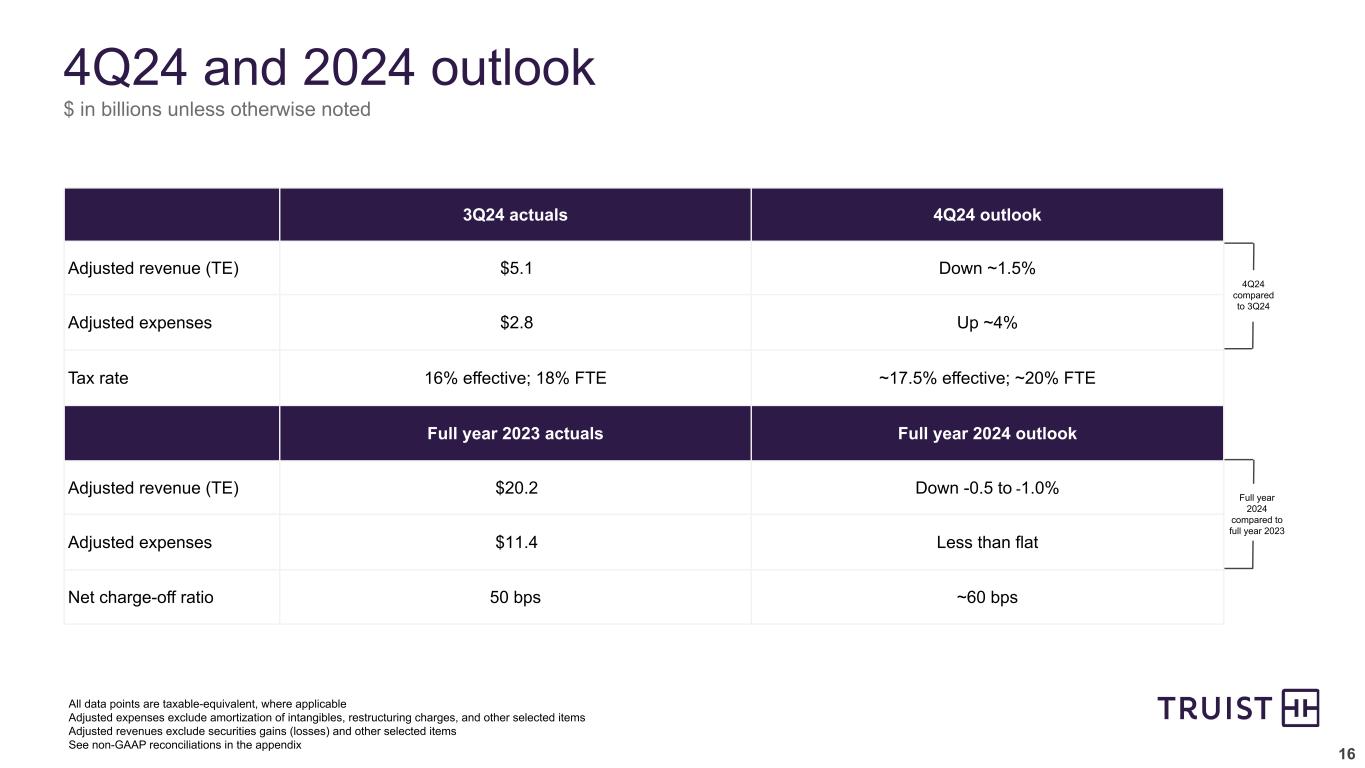
16 13.9% 4Q24 and 2024 outlook All data points are taxable-equivalent, where applicable Adjusted expenses exclude amortization of intangibles, restructuring charges, and other selected items Adjusted revenues exclude securities gains (losses) and other selected items See non-GAAP reconciliations in the appendix Full year 2024 compared to full year 2023 4Q24 compared to 3Q24 $ in billions unless otherwise noted 3Q24 actuals 4Q24 outlook Adjusted revenue (TE) $5.1 Down ~1.5% Adjusted expenses $2.8 Up ~4% Tax rate 16% effective; 18% FTE ~17.5% effective; ~20% FTE Full year 2023 actuals Full year 2024 outlook Adjusted revenue (TE) $20.2 Down -0.5 to -1.0% Adjusted expenses $11.4 Less than flat Net charge-off ratio 50 bps ~60 bps
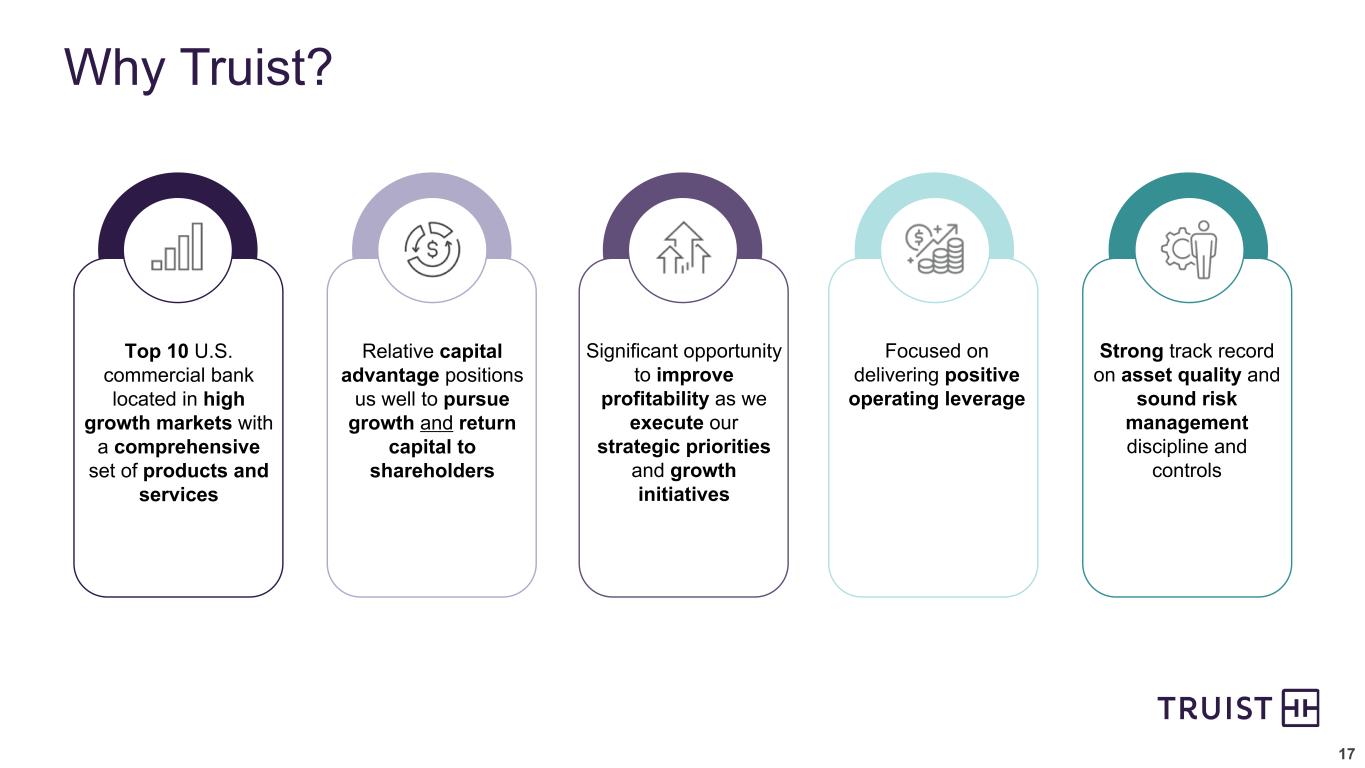
17 Top 10 U.S. commercial bank located in high growth markets with a comprehensive set of products and services Relative capital advantage positions us well to pursue growth and return capital to shareholders Significant opportunity to improve profitability as we execute our strategic priorities and growth initiatives Focused on delivering positive operating leverage Strong track record on asset quality and sound risk management discipline and controls Why Truist?

Appendix

A-19 Multi Tenant 88% Medical 9% Single Tenant 3% Hotel 8% Industrial 19% Office 15% Multifamily 35% Retail 13% Other 10% 11.3% 11.7% 13.7% 13.5% 1.09% 1.05% 0.96% 1.22% 1.05% 1.02% 0.70% 1.30% 1.23% 0.83% Criticized & classified ratio NPL ratio NCO ratio 3Q23 4Q23 1Q24 2Q24 3Q24 CRE 9.5% 11% 32% 18% 16% 23% 2024 2025 2026 2027 2028 and beyond Commercial real estate update 5-quarter total CRE trends Total LHFI at 9/30/24 ($303.2B) CRE Office 1.5% CRE Mix Scheduled Office maturities CRE represents 9.5% of total loans HFI, including Office at 1.5% NPL% 5.1% LTM NCO ratio 5.9% Loan loss reserves 10.4% WALTV 62% % in Truist Southeast/ Mid-Atlantic footprint 74% Office spotlight All other loans 90.5% CRE information on this slide includes the commercial construction portfolio Gateway markets include: Washington, DC, San Francisco, New York, Chicago, Los Angeles, Boston, and Miami WALTV based on most recent appraisal conducted A-1 Office portfolio primarily composed of Multi Tenant, Non Gateway properties within footprint Gateway 35% Non Gateway 65% Tenant Type Market Type 18.2%
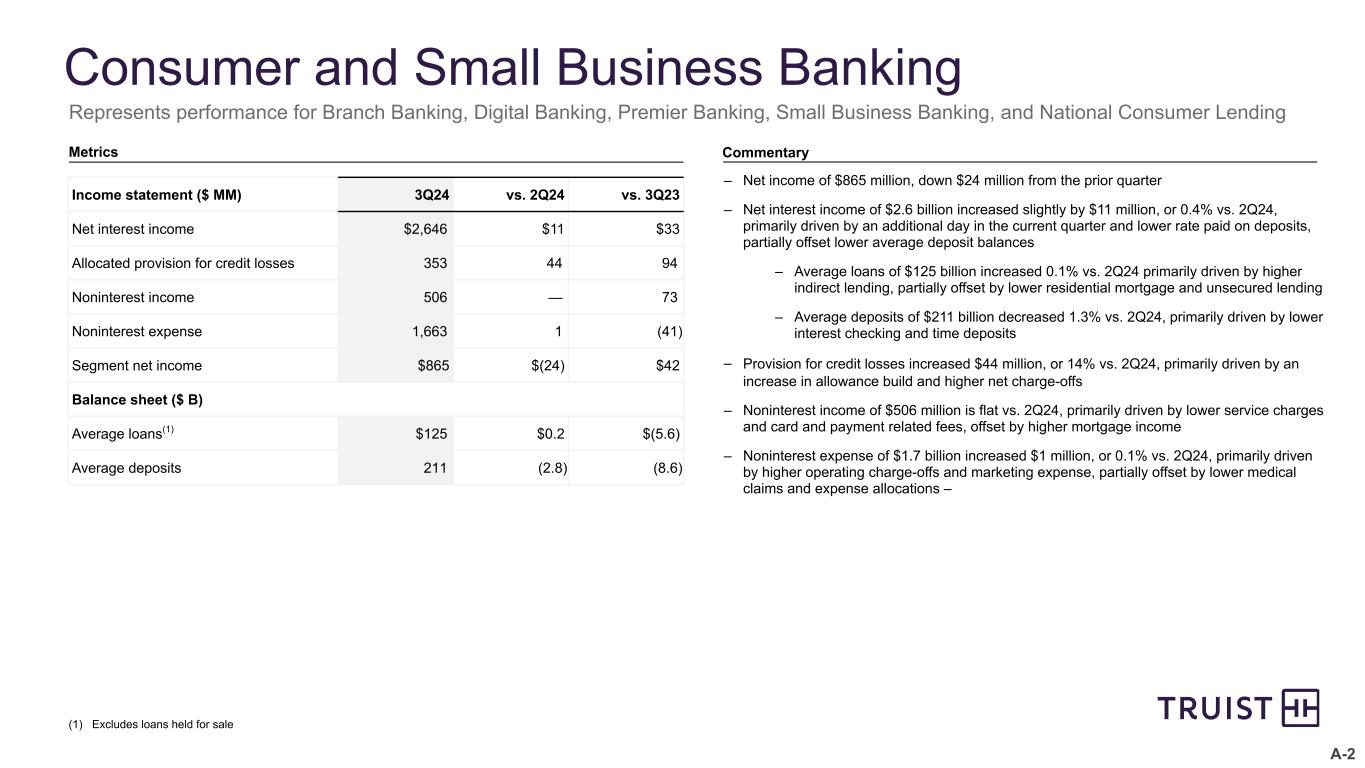
A-2 Consumer and Small Business Banking Income statement ($ MM) 3Q24 vs. 2Q24 vs. 3Q23 Net interest income $2,646 $11 $33 Allocated provision for credit losses 353 44 94 Noninterest income 506 — 73 Noninterest expense 1,663 1 (41) Segment net income $865 $(24) $42 Balance sheet ($ B) Average loans(1) $125 $0.2 $(5.6) Average deposits 211 (2.8) (8.6) (1) Excludes loans held for sale Represents performance for Branch Banking, Digital Banking, Premier Banking, Small Business Banking, and National Consumer Lending – Net income of $865 million, down $24 million from the prior quarter – Net interest income of $2.6 billion increased slightly by $11 million, or 0.4% vs. 2Q24, primarily driven by an additional day in the current quarter and lower rate paid on deposits, partially offset lower average deposit balances – Average loans of $125 billion increased 0.1% vs. 2Q24 primarily driven by higher indirect lending, partially offset by lower residential mortgage and unsecured lending – Average deposits of $211 billion decreased 1.3% vs. 2Q24, primarily driven by lower interest checking and time deposits – Provision for credit losses increased $44 million, or 14% vs. 2Q24, primarily driven by an increase in allowance build and higher net charge-offs – Noninterest income of $506 million is flat vs. 2Q24, primarily driven by lower service charges and card and payment related fees, offset by higher mortgage income – Noninterest expense of $1.7 billion increased $1 million, or 0.1% vs. 2Q24, primarily driven by higher operating charge-offs and marketing expense, partially offset by lower medical claims and expense allocations – Metrics Commentary
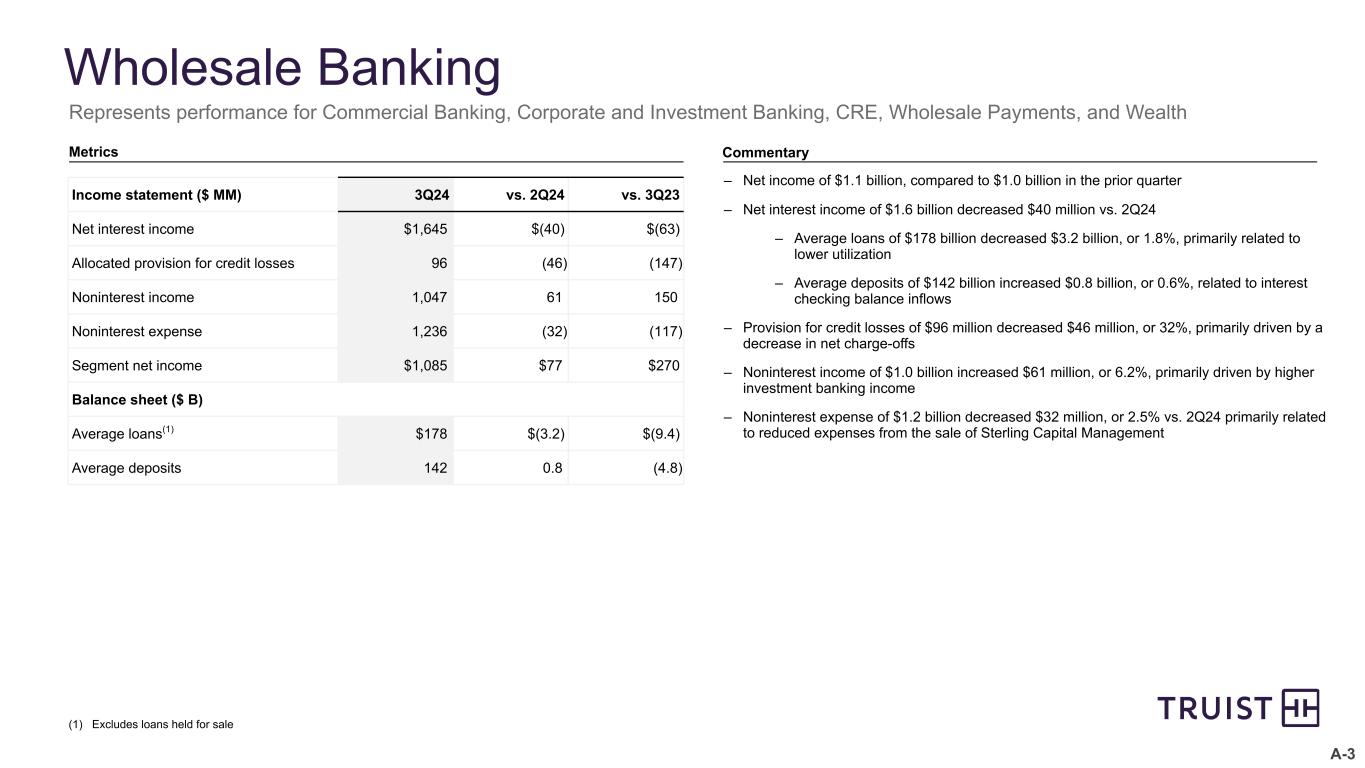
A-3 Wholesale Banking (1) Excludes loans held for sale Metrics Commentary Income statement ($ MM) 3Q24 vs. 2Q24 vs. 3Q23 Net interest income $1,645 $(40) $(63) Allocated provision for credit losses 96 (46) (147) Noninterest income 1,047 61 150 Noninterest expense 1,236 (32) (117) Segment net income $1,085 $77 $270 Balance sheet ($ B) Average loans(1) $178 $(3.2) $(9.4) Average deposits 142 0.8 (4.8) Represents performance for Commercial Banking, Corporate and Investment Banking, CRE, Wholesale Payments, and Wealth – Net income of $1.1 billion, compared to $1.0 billion in the prior quarter – Net interest income of $1.6 billion decreased $40 million vs. 2Q24 – Average loans of $178 billion decreased $3.2 billion, or 1.8%, primarily related to lower utilization – Average deposits of $142 billion increased $0.8 billion, or 0.6%, related to interest checking balance inflows – Provision for credit losses of $96 million decreased $46 million, or 32%, primarily driven by a decrease in net charge-offs – Noninterest income of $1.0 billion increased $61 million, or 6.2%, primarily driven by higher investment banking income – Noninterest expense of $1.2 billion decreased $32 million, or 2.5% vs. 2Q24 primarily related to reduced expenses from the sale of Sterling Capital Management
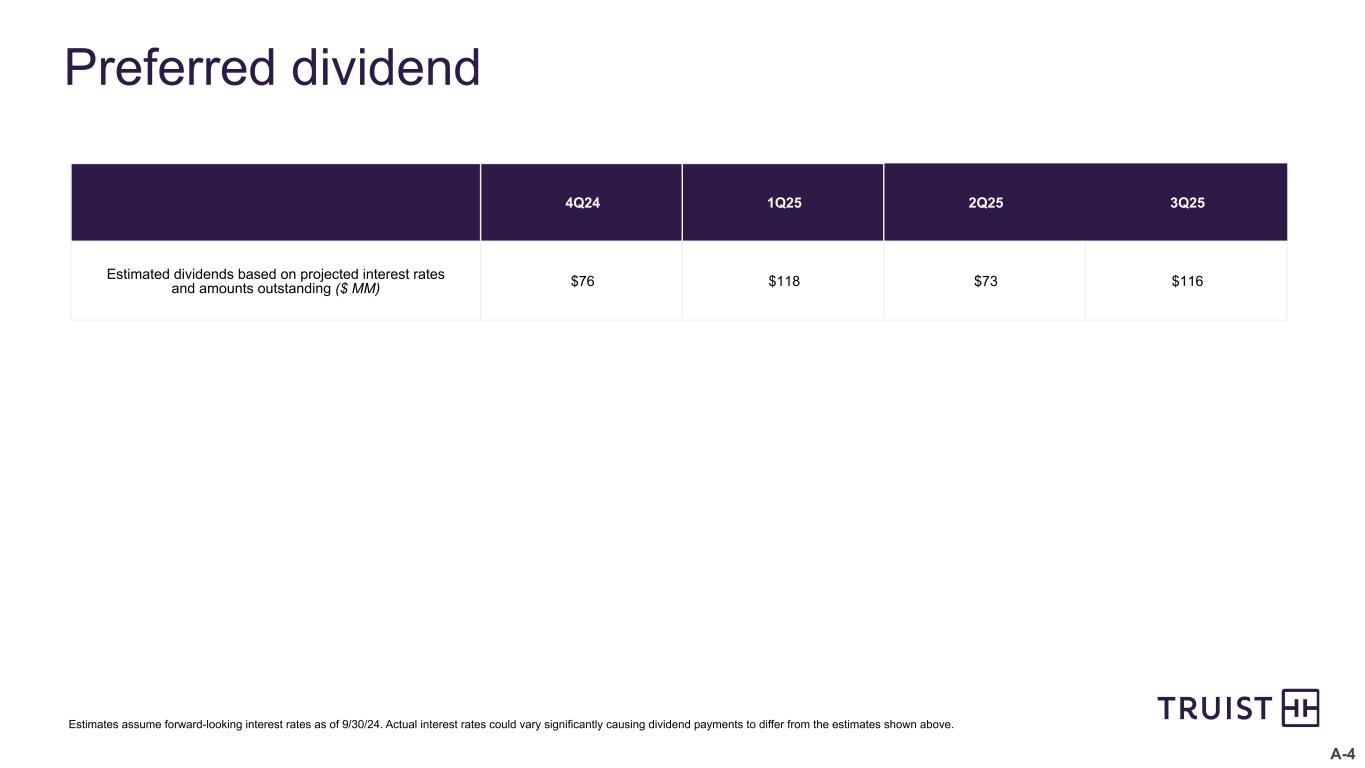
A-4 Preferred dividend 4Q24 1Q25 2Q25 3Q25 Estimated dividends based on projected interest rates and amounts outstanding ($ MM) $76 $118 $73 $116 Estimates assume forward-looking interest rates as of 9/30/24. Actual interest rates could vary significantly causing dividend payments to differ from the estimates shown above.
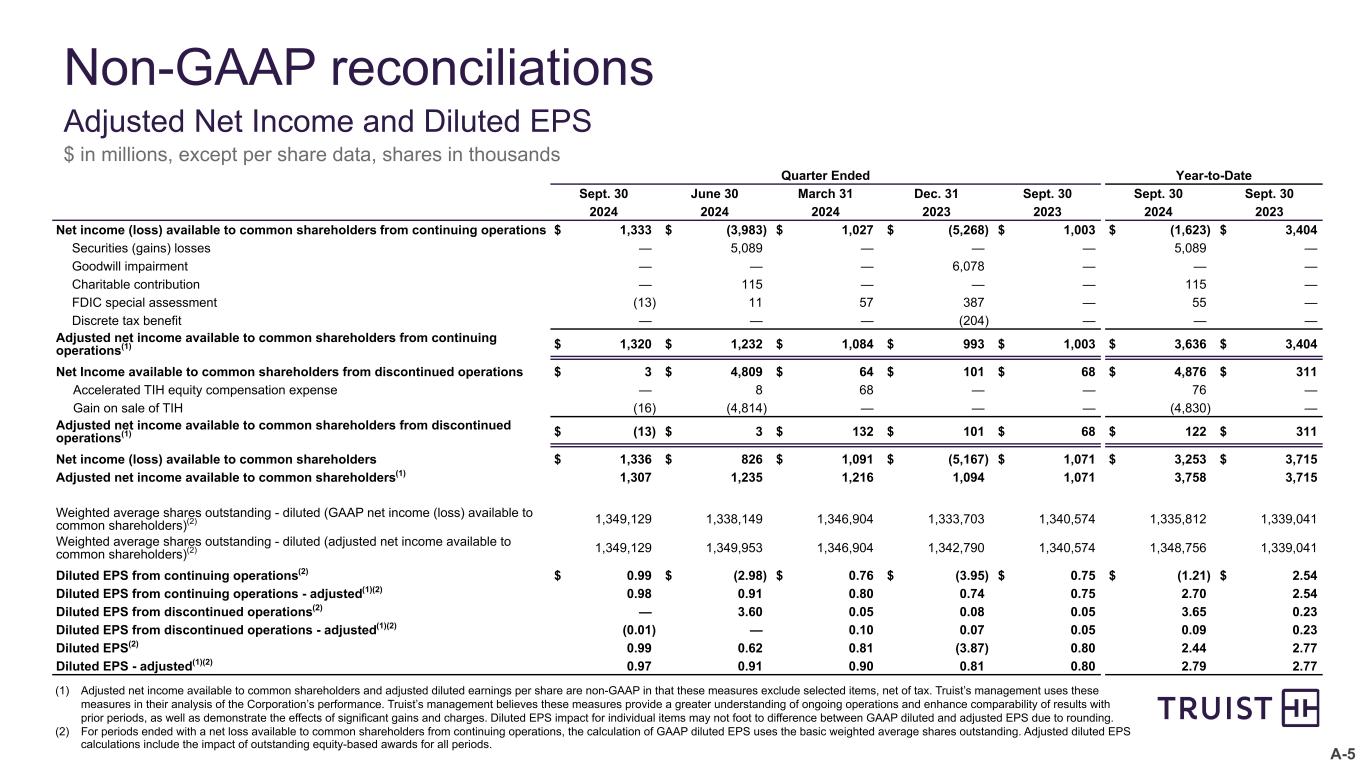
A-5 Quarter Ended Year-to-Date Sept. 30 June 30 March 31 Dec. 31 Sept. 30 Sept. 30 Sept. 30 2024 2024 2024 2023 2023 2024 2023 Net income (loss) available to common shareholders from continuing operations $ 1,333 $ (3,983) $ 1,027 $ (5,268) $ 1,003 $ (1,623) $ 3,404 Securities (gains) losses — 5,089 — — — 5,089 — Goodwill impairment — — — 6,078 — — — Charitable contribution — 115 — — — 115 — FDIC special assessment (13) 11 57 387 — 55 — Discrete tax benefit — — — (204) — — — Adjusted net income available to common shareholders from continuing operations(1) $ 1,320 $ 1,232 $ 1,084 $ 993 $ 1,003 $ 3,636 $ 3,404 Net Income available to common shareholders from discontinued operations $ 3 $ 4,809 $ 64 $ 101 $ 68 $ 4,876 $ 311 Accelerated TIH equity compensation expense — 8 68 — — 76 — Gain on sale of TIH (16) (4,814) — — — (4,830) — Adjusted net income available to common shareholders from discontinued operations(1) $ (13) $ 3 $ 132 $ 101 $ 68 $ 122 $ 311 Net income (loss) available to common shareholders $ 1,336 $ 826 $ 1,091 $ (5,167) $ 1,071 $ 3,253 $ 3,715 Adjusted net income available to common shareholders(1) 1,307 1,235 1,216 1,094 1,071 3,758 3,715 Weighted average shares outstanding - diluted (GAAP net income (loss) available to common shareholders)(2) 1,349,129 1,338,149 1,346,904 1,333,703 1,340,574 1,335,812 1,339,041 Weighted average shares outstanding - diluted (adjusted net income available to common shareholders)(2) 1,349,129 1,349,953 1,346,904 1,342,790 1,340,574 1,348,756 1,339,041 Diluted EPS from continuing operations(2) $ 0.99 $ (2.98) $ 0.76 $ (3.95) $ 0.75 $ (1.21) $ 2.54 Diluted EPS from continuing operations - adjusted(1)(2) 0.98 0.91 0.80 0.74 0.75 2.70 2.54 Diluted EPS from discontinued operations(2) — 3.60 0.05 0.08 0.05 3.65 0.23 Diluted EPS from discontinued operations - adjusted(1)(2) (0.01) — 0.10 0.07 0.05 0.09 0.23 Diluted EPS(2) 0.99 0.62 0.81 (3.87) 0.80 2.44 2.77 Diluted EPS - adjusted(1)(2) 0.97 0.91 0.90 0.81 0.80 2.79 2.77 Non-GAAP reconciliations Adjusted Net Income and Diluted EPS $ in millions, except per share data, shares in thousands (1) Adjusted net income available to common shareholders and adjusted diluted earnings per share are non-GAAP in that these measures exclude selected items, net of tax. Truist’s management uses these measures in their analysis of the Corporation’s performance. Truist’s management believes these measures provide a greater understanding of ongoing operations and enhance comparability of results with prior periods, as well as demonstrate the effects of significant gains and charges. Diluted EPS impact for individual items may not foot to difference between GAAP diluted and adjusted EPS due to rounding. (2) For periods ended with a net loss available to common shareholders from continuing operations, the calculation of GAAP diluted EPS uses the basic weighted average shares outstanding. Adjusted diluted EPS calculations include the impact of outstanding equity-based awards for all periods.
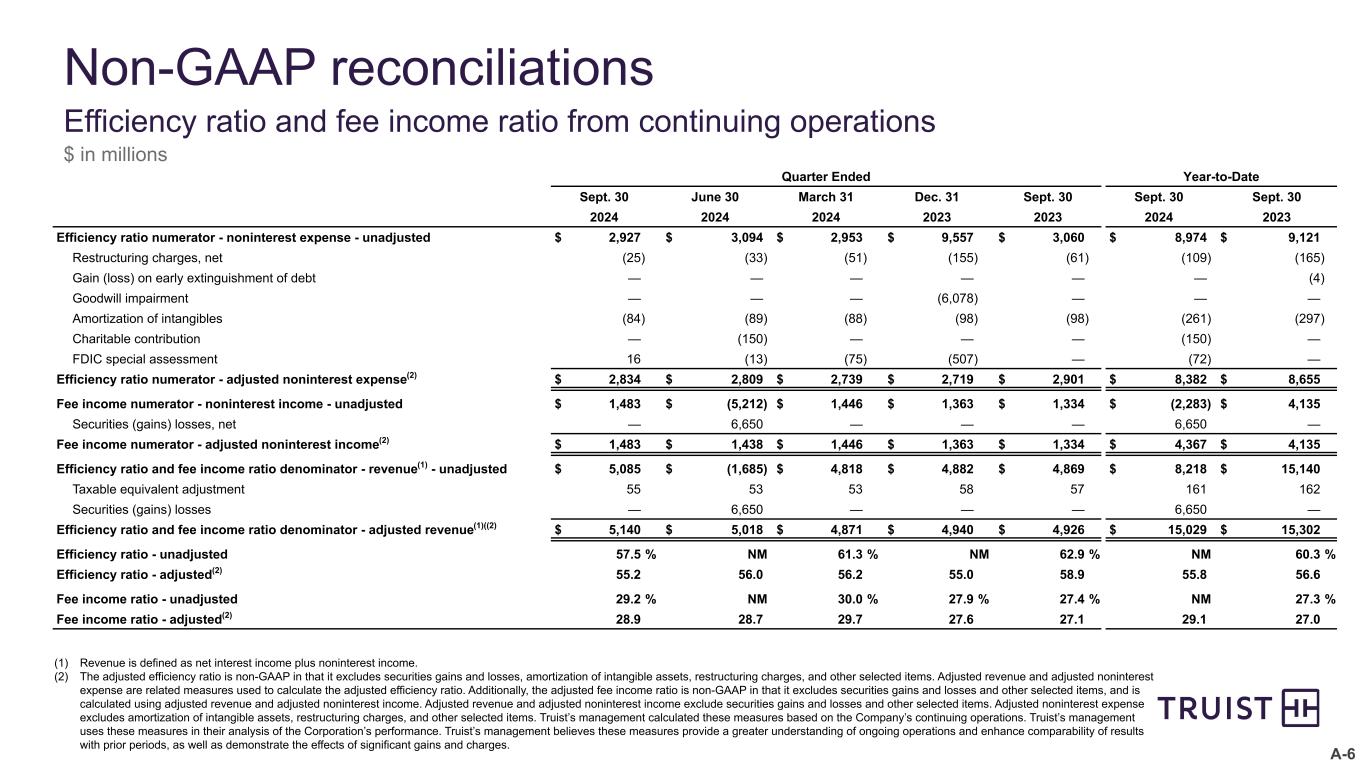
A-6 Non-GAAP reconciliations Efficiency ratio and fee income ratio from continuing operations $ in millions (1) Revenue is defined as net interest income plus noninterest income. (2) The adjusted efficiency ratio is non-GAAP in that it excludes securities gains and losses, amortization of intangible assets, restructuring charges, and other selected items. Adjusted revenue and adjusted noninterest expense are related measures used to calculate the adjusted efficiency ratio. Additionally, the adjusted fee income ratio is non-GAAP in that it excludes securities gains and losses and other selected items, and is calculated using adjusted revenue and adjusted noninterest income. Adjusted revenue and adjusted noninterest income exclude securities gains and losses and other selected items. Adjusted noninterest expense excludes amortization of intangible assets, restructuring charges, and other selected items. Truist’s management calculated these measures based on the Company’s continuing operations. Truist’s management uses these measures in their analysis of the Corporation’s performance. Truist’s management believes these measures provide a greater understanding of ongoing operations and enhance comparability of results with prior periods, as well as demonstrate the effects of significant gains and charges. Quarter Ended Year-to-Date Sept. 30 June 30 March 31 Dec. 31 Sept. 30 Sept. 30 Sept. 30 2024 2024 2024 2023 2023 2024 2023 Efficiency ratio numerator - noninterest expense - unadjusted $ 2,927 $ 3,094 $ 2,953 $ 9,557 $ 3,060 $ 8,974 $ 9,121 Restructuring charges, net (25) (33) (51) (155) (61) (109) (165) Gain (loss) on early extinguishment of debt — — — — — — (4) Goodwill impairment — — — (6,078) — — — Amortization of intangibles (84) (89) (88) (98) (98) (261) (297) Charitable contribution — (150) — — — (150) — FDIC special assessment 16 (13) (75) (507) — (72) — Efficiency ratio numerator - adjusted noninterest expense(2) $ 2,834 $ 2,809 $ 2,739 $ 2,719 $ 2,901 $ 8,382 $ 8,655 Fee income numerator - noninterest income - unadjusted $ 1,483 $ (5,212) $ 1,446 $ 1,363 $ 1,334 $ (2,283) $ 4,135 Securities (gains) losses, net — 6,650 — — — 6,650 — Fee income numerator - adjusted noninterest income(2) $ 1,483 $ 1,438 $ 1,446 $ 1,363 $ 1,334 $ 4,367 $ 4,135 Efficiency ratio and fee income ratio denominator - revenue(1) - unadjusted $ 5,085 $ (1,685) $ 4,818 $ 4,882 $ 4,869 $ 8,218 $ 15,140 Taxable equivalent adjustment 55 53 53 58 57 161 162 Securities (gains) losses — 6,650 — — — 6,650 — Efficiency ratio and fee income ratio denominator - adjusted revenue(1)((2) $ 5,140 $ 5,018 $ 4,871 $ 4,940 $ 4,926 $ 15,029 $ 15,302 Efficiency ratio - unadjusted 57.5 % NM 61.3 % NM 62.9 % NM 60.3 % Efficiency ratio - adjusted(2) 55.2 56.0 56.2 55.0 58.9 55.8 56.6 Fee income ratio - unadjusted 29.2 % NM 30.0 % 27.9 % 27.4 % NM 27.3 % Fee income ratio - adjusted(2) 28.9 28.7 29.7 27.6 27.1 29.1 27.0
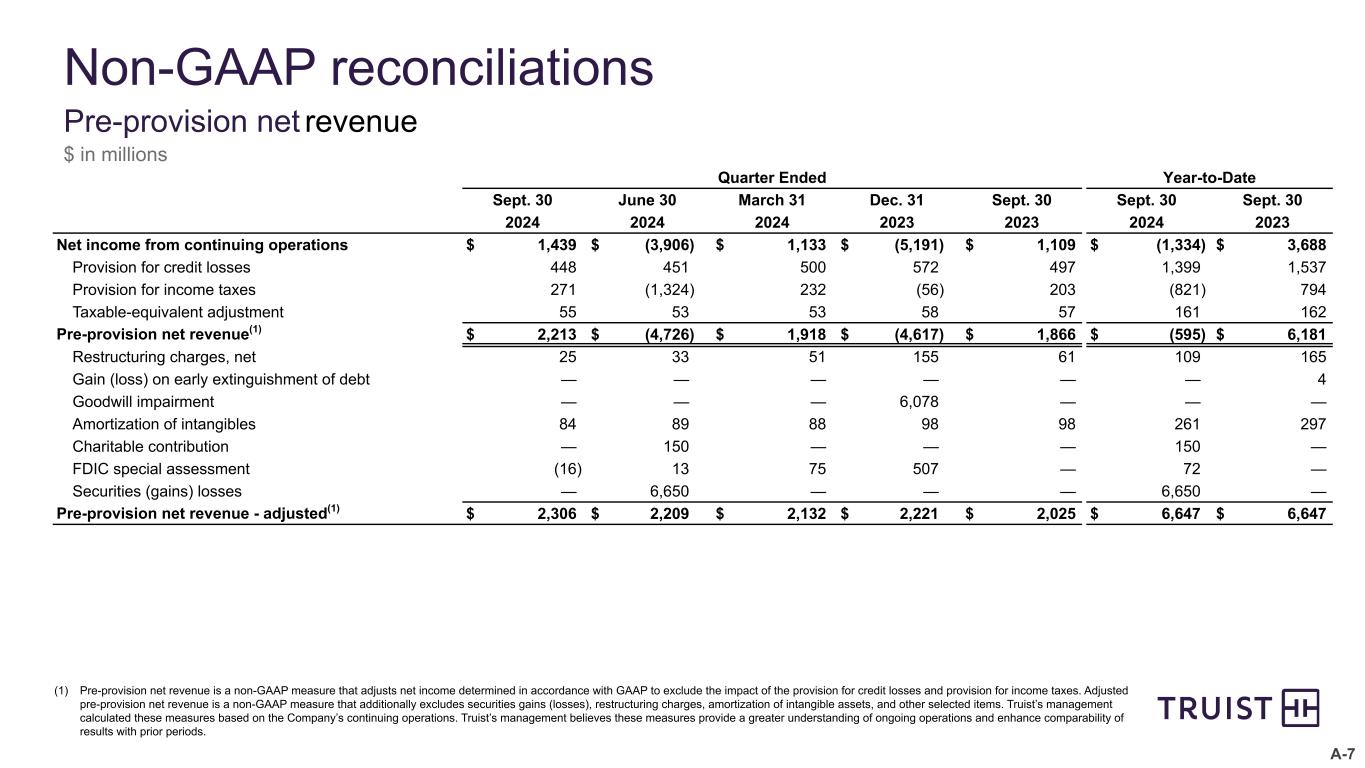
A-7 Non-GAAP reconciliations Pre-provision net revenue $ in millions (1) Pre-provision net revenue is a non-GAAP measure that adjusts net income determined in accordance with GAAP to exclude the impact of the provision for credit losses and provision for income taxes. Adjusted pre-provision net revenue is a non-GAAP measure that additionally excludes securities gains (losses), restructuring charges, amortization of intangible assets, and other selected items. Truist’s management calculated these measures based on the Company’s continuing operations. Truist’s management believes these measures provide a greater understanding of ongoing operations and enhance comparability of results with prior periods. Quarter Ended Year-to-Date Sept. 30 June 30 March 31 Dec. 31 Sept. 30 Sept. 30 Sept. 30 2024 2024 2024 2023 2023 2024 2023 Net income from continuing operations $ 1,439 $ (3,906) $ 1,133 $ (5,191) $ 1,109 $ (1,334) $ 3,688 Provision for credit losses 448 451 500 572 497 1,399 1,537 Provision for income taxes 271 (1,324) 232 (56) 203 (821) 794 Taxable-equivalent adjustment 55 53 53 58 57 161 162 Pre-provision net revenue(1) $ 2,213 $ (4,726) $ 1,918 $ (4,617) $ 1,866 $ (595) $ 6,181 Restructuring charges, net 25 33 51 155 61 109 165 Gain (loss) on early extinguishment of debt — — — — — — 4 Goodwill impairment — — — 6,078 — — — Amortization of intangibles 84 89 88 98 98 261 297 Charitable contribution — 150 — — — 150 — FDIC special assessment (16) 13 75 507 — 72 — Securities (gains) losses — 6,650 — — — 6,650 — Pre-provision net revenue - adjusted(1) $ 2,306 $ 2,209 $ 2,132 $ 2,221 $ 2,025 $ 6,647 $ 6,647
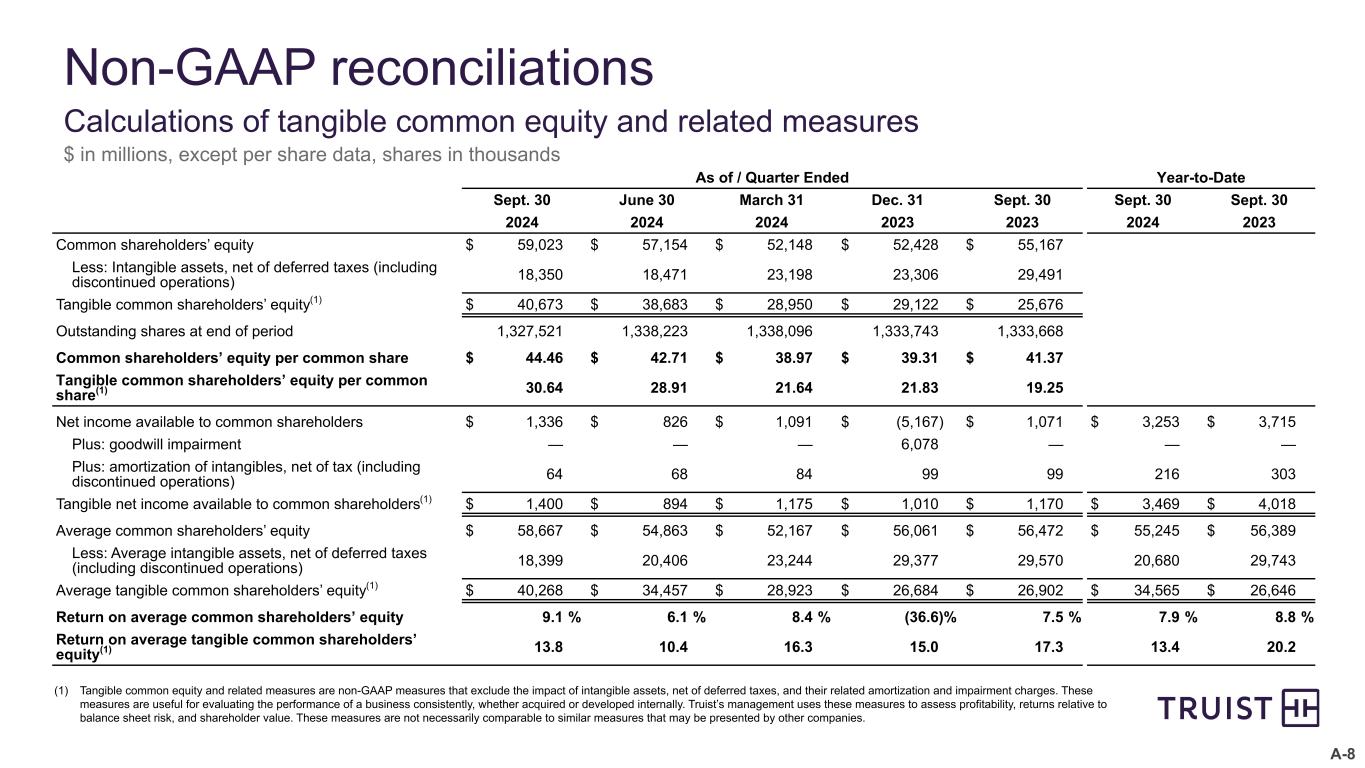
A-8 Non-GAAP reconciliations Calculations of tangible common equity and related measures $ in millions, except per share data, shares in thousands (1) Tangible common equity and related measures are non-GAAP measures that exclude the impact of intangible assets, net of deferred taxes, and their related amortization and impairment charges. These measures are useful for evaluating the performance of a business consistently, whether acquired or developed internally. Truist’s management uses these measures to assess profitability, returns relative to balance sheet risk, and shareholder value. These measures are not necessarily comparable to similar measures that may be presented by other companies. As of / Quarter Ended Year-to-Date Sept. 30 June 30 March 31 Dec. 31 Sept. 30 Sept. 30 Sept. 30 2024 2024 2024 2023 2023 2024 2023 Common shareholders’ equity $ 59,023 $ 57,154 $ 52,148 $ 52,428 $ 55,167 Less: Intangible assets, net of deferred taxes (including discontinued operations) 18,350 18,471 23,198 23,306 29,491 Tangible common shareholders’ equity(1) $ 40,673 $ 38,683 $ 28,950 $ 29,122 $ 25,676 Outstanding shares at end of period 1,327,521 1,338,223 1,338,096 1,333,743 1,333,668 Common shareholders’ equity per common share $ 44.46 $ 42.71 $ 38.97 $ 39.31 $ 41.37 Tangible common shareholders’ equity per common share(1) 30.64 28.91 21.64 21.83 19.25 Net income available to common shareholders $ 1,336 $ 826 $ 1,091 $ (5,167) $ 1,071 $ 3,253 $ 3,715 Plus: goodwill impairment — — — 6,078 — — — Plus: amortization of intangibles, net of tax (including discontinued operations) 64 68 84 99 99 216 303 Tangible net income available to common shareholders(1) $ 1,400 $ 894 $ 1,175 $ 1,010 $ 1,170 $ 3,469 $ 4,018 Average common shareholders’ equity $ 58,667 $ 54,863 $ 52,167 $ 56,061 $ 56,472 $ 55,245 $ 56,389 Less: Average intangible assets, net of deferred taxes (including discontinued operations) 18,399 20,406 23,244 29,377 29,570 20,680 29,743 Average tangible common shareholders’ equity(1) $ 40,268 $ 34,457 $ 28,923 $ 26,684 $ 26,902 $ 34,565 $ 26,646 Return on average common shareholders’ equity 9.1 % 6.1 % 8.4 % (36.6) % 7.5 % 7.9 % 8.8 % Return on average tangible common shareholders’ equity(1) 13.8 10.4 16.3 15.0 17.3 13.4 20.2

























